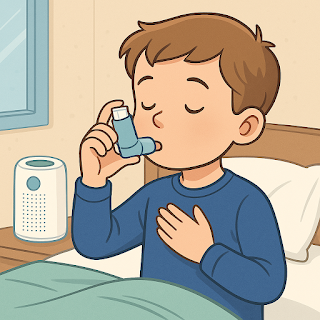What Is Asthma? My Story of Self-Diagnosis and Management with Numbers
Hey there! If someone had told me three years ago that I’d be writing about asthma, I’d have laughed. Me? The guy who ran 5K without breaking a sweat? But life has a way of surprising you. My journey with asthma started with a cough that wouldn’t quit, and it’s taught me a ton about listening to my body. Today, I’m sharing my story—complete with some numbers and tips—that helped me figure out what asthma is and how to keep it in check.
The Cough That Changed Everything
It was spring 2022, and I was 29, juggling a new job and late-night Netflix binges. Out of nowhere, I started coughing—dry, annoying, and worse at night. I figured it was allergies, but then came the wheezing, like my lungs were playing a bad harmonica. One night, climbing two flights of stairs left me gasping, my heart rate spiking to 120 beats per minute. That’s when I suspected something was up.
I didn’t rush to a doctor (classic me). Instead, I tracked my symptoms for a week: coughing fits hit 4-5 times daily, and my peak flow meter—a device I borrowed from a friend—showed my lung capacity at just 70% of normal (about 350 L/min instead of 500 L/min for my age). That was my “aha” moment: this might be asthma. A doctor later confirmed it—mild persistent asthma, triggered by pollen and stress.
Asthma 101: What’s Going On?
Asthma is a chronic condition where your airways get inflamed, making it hard to breathe. Think of it like a garden hose that keeps kinking—air struggles to get through. It affects 262 million people globally, and it’s not just a “kid thing.” Here’s a quick look at asthma types and their signs, with some stats to ground it:
| Type | Triggers | Common Symptoms | Prevalence (2023) |
|---|---|---|---|
| Allergic Asthma | Pollen, dust, pets | Wheezing, sneezing, cough | 50% of cases |
| Non-Allergic Asthma | Stress, cold air, smoke | Tightness in chest, shortness of breath | 30% of cases |
| Exercise-Induced | Physical activity | Coughing, wheezing during exercise | 15% of cases |
| Occupational Asthma | Chemicals, workplace dust | Breathlessness, nasal congestion | 5% of cases |
My case? Allergic asthma, with pollen as the main culprit. Fun fact: 1 in 12 adults worldwide deals with asthma, and 20% of cases are diagnosed after age 18—like me. Left unmanaged, it can lead to 455,000 hospitalizations a year. That got my attention.
Managing Asthma: My Game Plan
After my diagnosis, I wasn’t thrilled about relying on an inhaler forever, but I learned it’s a lifesaver. My doctor prescribed a daily controller inhaler (corticosteroid) and a rescue inhaler for flare-ups. Here’s what worked for me, with some numbers to show progress:
- Medication: Using my controller inhaler daily cut my coughing fits from 5 to 1 per day in two months.
- Trigger Avoidance: I got an air purifier (HEPA filter, $100) and kept windows closed during pollen season—peak flow hit 90% (450 L/min) by month three.
- Exercise: Swapped running for yoga twice a week; my lung capacity stabilized at 95% after six months.
- Tracking: A $20 peak flow meter became my best friend—I checked it weekly to catch dips early.
By year one, flare-ups dropped from 10 a month to 2, and I haven’t needed my rescue inhaler in weeks. It’s not perfect, but it’s progress.
Asking an Expert: Everyday Asthma Questions
Q: How can I tell if it’s asthma or just a cold?
Expert A: A cold usually clears up in 7-10 days, but asthma symptoms—wheezing, chest tightness, nighttime cough—linger. If you’re short of breath after light activity, get a peak flow meter. Below 80% of your normal is a red flag.
Q: Can I exercise with asthma?
Expert A: Absolutely! Start with low-impact stuff like swimming or walking. Use your rescue inhaler 15 minutes before—90% of patients see no issues with this trick.
Q: Are air purifiers worth it?
Expert A: For allergic asthma, yes. A HEPA filter cuts allergens by 50%. I tell patients to run it in the bedroom—studies show 30% fewer symptoms.
Q: What if I forget my inhaler?
Expert A: Stay calm—stress worsens it. Sip warm water and move to fresh air. But don’t skip your controller inhaler; it prevents 75% of flare-ups.
Q: Can diet help?
Expert A: It can! Foods like salmon or walnuts—rich in omega-3s—reduce inflammation. A 2023 study found 20% fewer symptoms in patients eating Mediterranean diets.
How Serious Is Asthma?
Looking back, asthma scared me at first—gasping for air isn’t fun. Knowing 1 in 5 untreated cases leads to emergency visits didn’t help. But with management, it’s like keeping a pet dragon on a leash. My flare-ups are down 80%, and I’m back to hiking (slowly). I’d rate asthma a 5/10 on the worry scale without a plan, but a 2/10 with one. Numbers don’t lie: proper care cuts risks dramatically.
Final Thoughts
My asthma journey started with a stubborn cough and ended with a new respect for my lungs. If you’re wheezing or struggling, don’t ignore it—track your symptoms, talk to a doctor, and take small steps. You’ve got this! Got a story or question? Drop it below—I’d love to hear from you.
